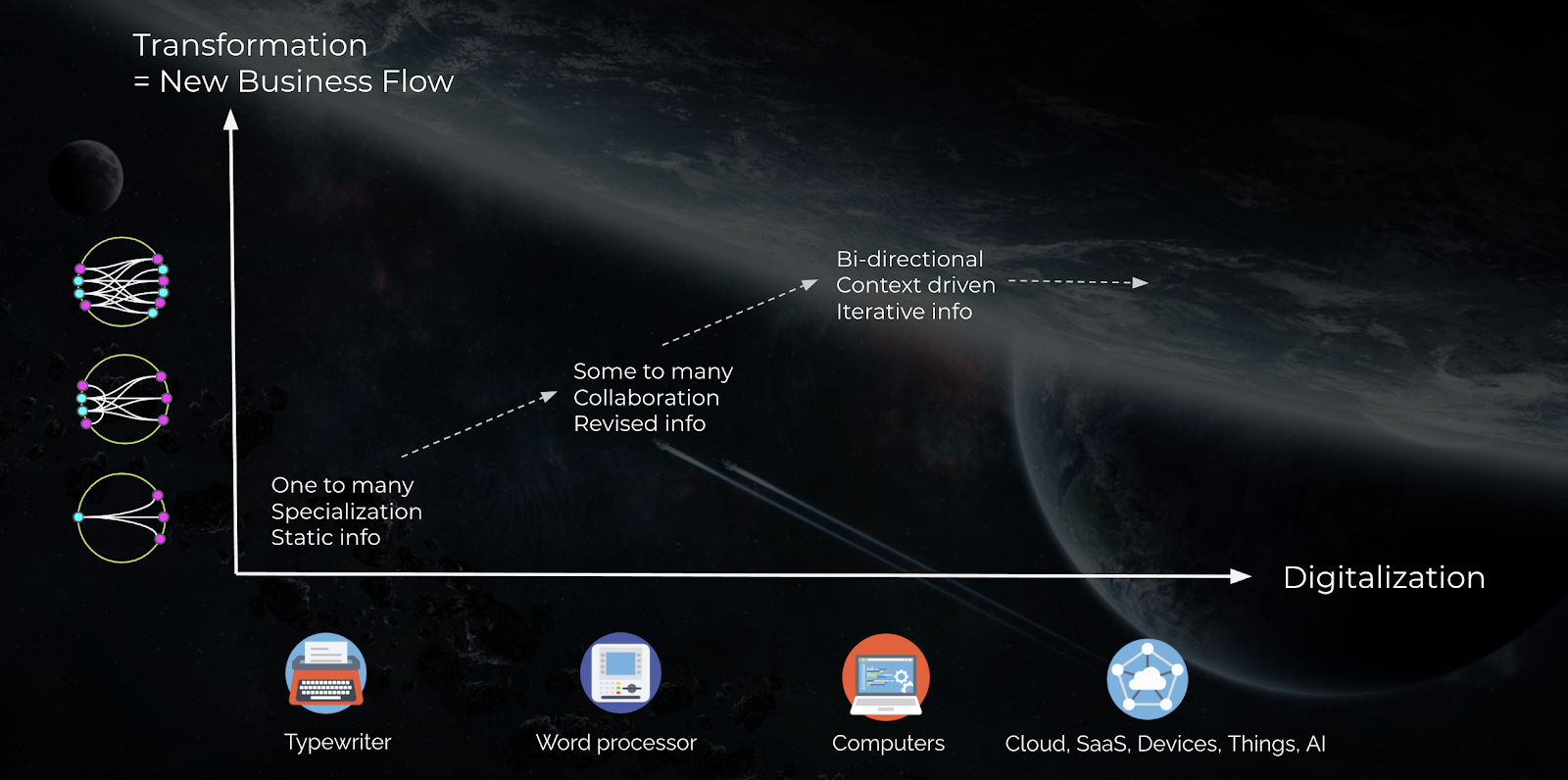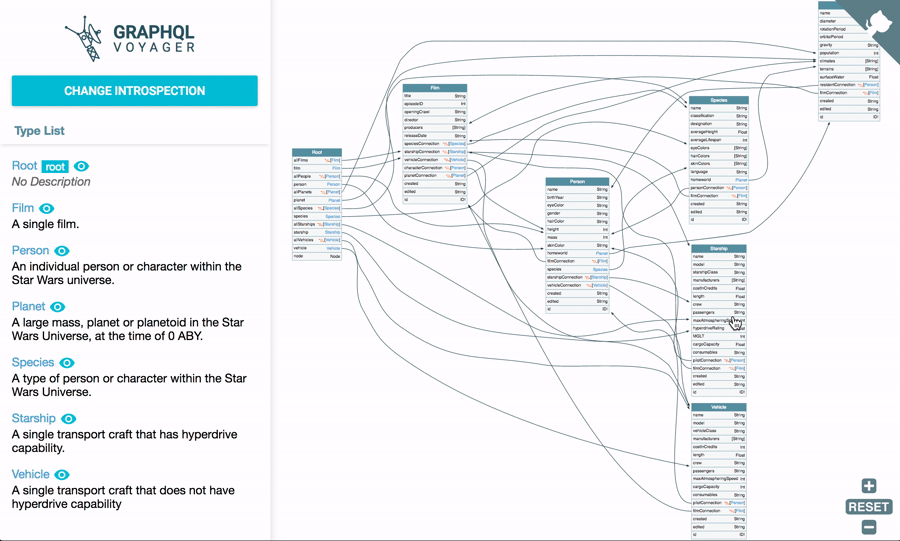To digitally transform is a challenge – and it’s now on the table in virtually every business worldwide. This post will help you avoid pitfalls in your digital transformation.

I’m going to break it to you right away: The #1 reason for failure in digital transformation is failure to reorganize your information flows. Huh? Say what?! Okay, let me explain.
“Digital transformation” implies:
- transforming a business - i.e., creating new business flows…
- ...by digitalization
Let’s make this clearer by separating business transformation (on the y-axis) from digitalization (on the x-axis).

To further clarify: When we refer to information, we mean the information that flows through a business. This can be a product or service (e.g., a book, movie, weather forecast, or bank loan). Information can also directly or indirectly power the experience of a service or product (e.g., a user guide, order form, contract, invoice, stock info, price tag, schedule, employee record, or financial statement).
As we go along, we will look at how to accomplish stepwise transformation by reorganizing information flows - aided by digitalization. Reorganization of information flows are described as three characteristics that undergo stepwise change:
| Information producers and consumers |
|
| Information character |
|
| Information timeliness |
|
LEVEL 1 - ANALOGUE BUSINESS
Now, let’s assume you are running an analogue business powered by typewriters. Your business flows have three characteristics:
| One to many |
By one producer for many consumers |
| Specialization |
Information is specialized and sorted |
| Static info |
Hard to change and therefore not updated frequently |
At this level we have a non-complex organization of producers (blue) and consumers (purple).
An example is printing a book from one author to multiple readers. The book needs to be categorized as belonging to a special area (since print books are not electronically searchable). It is seldom revised because a print book revision is costly.

LEVEL 2 - INSIDE-OUT DIGITAL TRANSFORMATION
Let’s take a step on the digitalization axis by replacing the typewriters with word processors.
Digitalization gives you the potential to reorganize information flows to transform your business. However, this potential is only realized if you make a conscious decision to reorganize the information flows. Digitalization without reorganization of information flow will at most give you some gain in efficiency without a business transformation.
The transformation enabled by word processors can be described as reorganizing information flow to:
| Some to many |
A set of co-producers to many consumers |
| Collaboration |
Searchable information that can be found in more than one context |
| Revised info |
Easier to update and republish information from producers to consumers |
Reorganization of information flows has introduced some complexity by adding co-producers (blue) and more consumers (purple). In addition, the information is now searchable by consumers and can be revised by producers more frequently.
Going back to our book example, we can now have several authors producing the book together. Because the book is electronically searchable, we can find it in many different contexts (no need to sort it into a category). The book can easily be revised.

LEVEL 3 - OUTSIDE-IN DIGITAL TRANSFORMATION
At the next level we digitalize on the consumer side of our information flows by introducing consumer computers. As before, this gives you the potential to reorganize information flows further to transform your business. Again, if you fail to do this reorganization, you miss out on business transformation.

The transformation enabled by consumer computers can be described as reorganizing information flow to:
| Bidirectional |
A set of co-producers to many consumers, with consumers giving feedback to the producers |
| Context driven |
Information is delivered to unique channels and consumer experiences |
| Iterative info |
Information is continuously updated and can be published in sections |
Reorganization of information flows has now introduced complexity by allowing consumers (purple) to also act as producers (blue) as information is fed back to the business from consumers.
Allowing consumers to act as producers of information enables a “learning organization” that uses external knowledge to impact its products and services. This feedback loop will, over time, outperform competitors who are still on level 1.

Continuing with our book example, we can now say that we have moved on to a type of business more similar to Netflix, where our publishing is based not only on our own editorial competence but also on the consumer feedback we are continuously gathering to impact our content. Because revisions are easy to do, we can start releasing content chapter by chapter or episode by episode with consumer feedback influencing the content of our next release.
Note: This feedback does not have to come directly from consumers, e.g., by voting or liking content, but can be more elaborate analytics such as “most watched episode,” “time viewers dropped off while watching episode,” “minutes watched,” “time viewers most paused while watching episode,” etc. These consumer insights will allow us to improve our content episode by episode.
LEVEL 4 - NETWORKED DIGITAL TRANSFORMATION
At this level we digitalize by introducing various producer and consumer devices that can access information in an “omni channel” experience, i.e., the information produced and consumed is channel agnostic with the tech being used of lower importance. The phrase “bring your own device” emerged as a result of a more open and interconnected world. As before, this gives you the potential to reorganize information flows further to transform your business. Again, if you fail to do this reorganization, you miss out on business transformation.

The transformation enabled by omni channel technology can be described as reorganizing information flow:
| Any to any |
Interconnected parties interchangeably acting as consumers and producers |
| Networked |
Information is tailored for a specific purpose, based on the rest of the network’s |
| Flowing info |
Information is instant and real-time |

The organization of information flows is now highly sophisticated. All participants in the business model are networked and interchanging information in solutions powered by APIs for data access and/or streams of events for instant access to real-time updates of information. This is called “the application network” of a business. One or more interconnected businesses form a “network of networks”.
This leap in transformation has been rare in the past but is now increasing in a new category of businesses called “disruptors” with a level of business sophistication that outperforms the lower-level alternatives. We have now moved from a Netflix type of business to two-sided marketplaces (e.g., YouTube, Uber, and Airbnb), interconnected, intelligent Internet of Things businesses (e.g., self-driving cars with decision making based on large-scale dataflow and AI with machine learning of driver community behaviors), and any other information-driven businesses that have moved fully into the information economy by understanding that “data is the new oil.”
SUMMARY
Avoid the pitfall of digitalization without transformation by conceptualizing your digital transformation as deliberate reorganization of your information flows into an application network as described in steps 1-4.
Use a tool to organize and visualize your information flows, which equips your developer community take your business to higher levels. Check out Starlify and get your information flows organized for you.
Take me to Starlify
If you are already on the path of digitalization, make sure to accelerate it by enabling your developer community! Read more about how we enabled Volvo Cars' developer community here.

.png)



















.png?width=2313&name=Group%206893-2%20(1).png)


